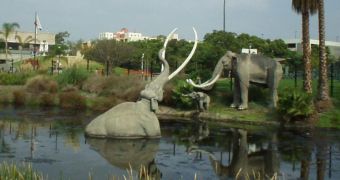Bacteria come from hell. They can survive in the toughest environments.
Now a team at UC Riverside has found in the Rancho La Brea tar pits in midtown Los Angeles, California, hundreds of new bacterial species that live in heavy oil and natural asphalt!
Inside the 28,000 years old mix of soil and heavy oil, the bacteria survive due to three previously unknown enzyme types that can break down the petroleum chemicals.
"We were surprised to find these bacteria because asphalt is an extreme and hostile environment for life to survive," said co-author Jong-Shik Kim, a postdoctoral researcher in the Department of Environmental Sciences.
"It's clear, however, that these living organisms can survive in heavy oil mixtures containing many highly toxic chemicals. Moreover, these bacteria survive with no water and little or no oxygen."
These bacteria could be useful in bioremediation (cleaning oil spills), alternative energy (biofuels), enhanced oil recovery, industrial applications (biochemicals and biotechnology) and drug industry.
The team identified the new bacteria and their enzymes based on their DNA analyses.
"Previously, some bacteria had been cultured from the asphalt, but no one had been able to extract DNA from the asphalt to study the entire microbial community," said Kim.
The Rancho La Brea tar pits, located in Hancock Park, Los Angeles, are one of the world's most known fossil sites that have provided the largest and most diverse assemblage of extinct ice age flora and fauna in the world, from mammoths to saber-toothed tigers and giant ground sloths.
"The living bacteria contained in the asphalt are most likely the progeny of soil microorganisms that were trapped in the asphalt, although some may also have been carried to the surface in the heavy oil that seeped upwards from deep underground oil reservoirs," said co-author David E. Crowley, a professor of environmental microbiology,
The researchers detected over 200 new bacteria species, classified on entirely new families and evolutionary branches.
The closest relatives of these bacteria are known to stand in high salt, toxic, or even radioactive environments.
"One family that was represented by many species is related to a group of bacteria that are the most radiation-resistant organisms on the planet. Indeed, this family of bacteria has been previously investigated by the Department of Energy for cleanup of hydrocarbon contamination in radioactive environments." explained Crowley.
The interest of the researchers was triggered by the continual emergence of methane bubbles from the heavy oil overlying the asphalts that made them investigate the asphalt.
"In the absence of oxygen, methane is produced by bacteria that use carbon dioxide for respiration instead of oxygen," said Crowley.
The bacteria were found to be distributed unevenly inside the tar pits.
"Probably there has also been genetic exchange and natural selection of new species over the thousands of years the bacteria have been living in the asphalt," Crowley said.
To achieve the bacterial DNA from the tar, the researchers first froze it with liquid nitrogen and then pulverized it using a mortar and pestle, being purified after that with standard methods.
Next, the researchers want to detect the genes that could have practical applications for petroleum processing, oil recovery and biotechnology.

 14 DAY TRIAL //
14 DAY TRIAL //